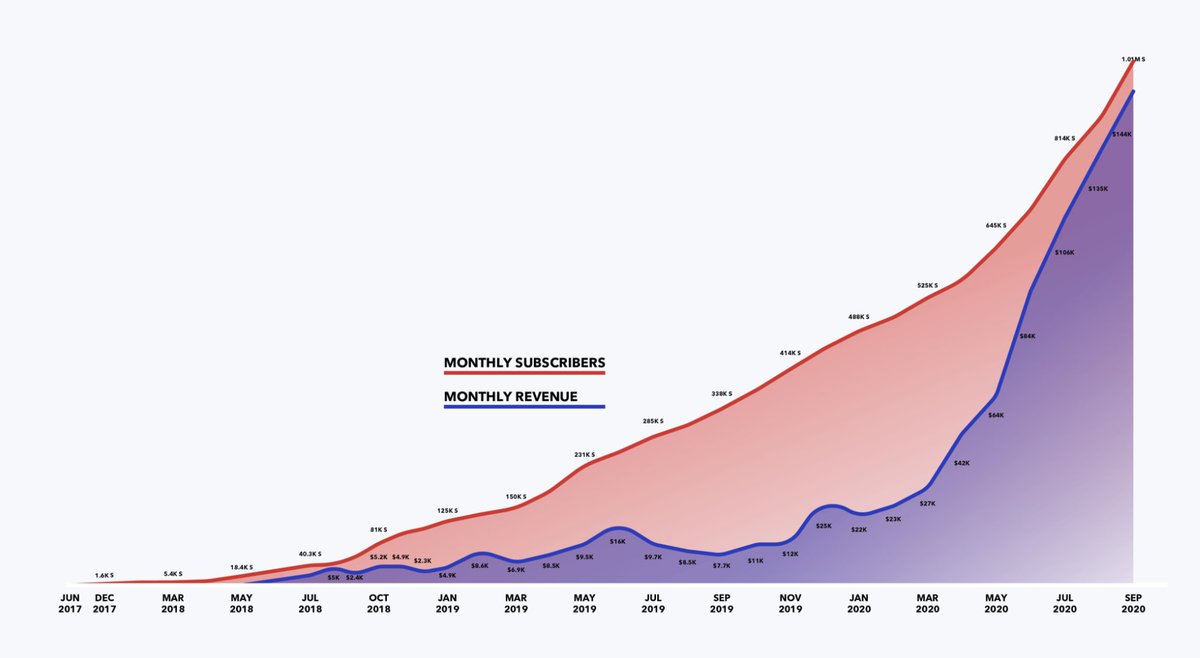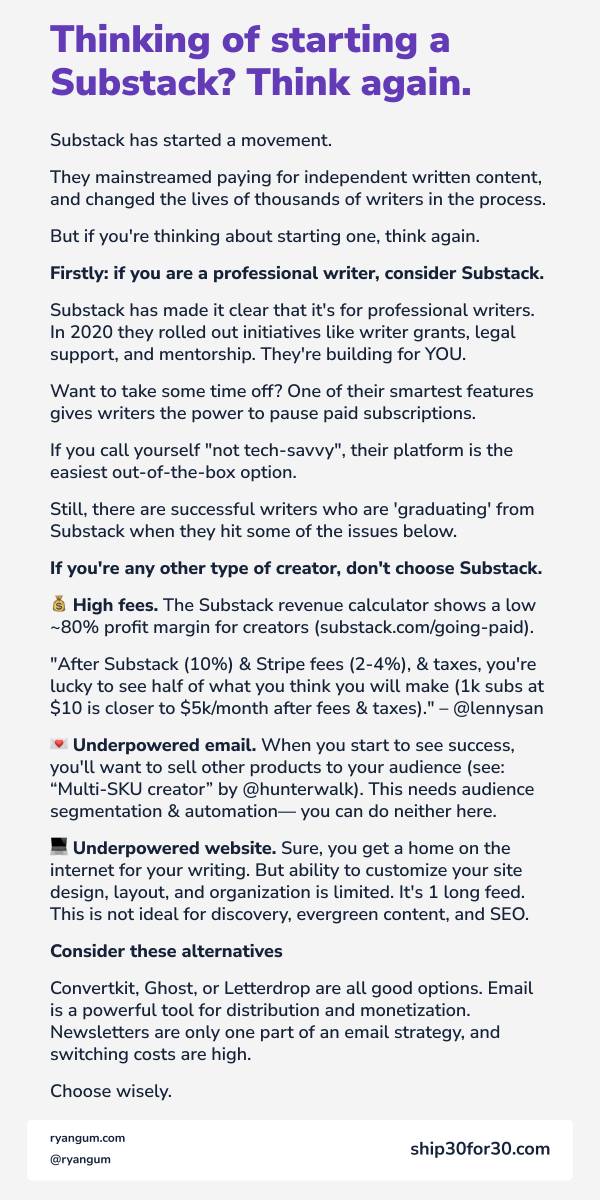
The most common question I'm asked is: "how did we grow Teachable?"
In 7 years we've helped over 100k creators sell more than $1B in courses & coaching.
Here's the story of how we did it.
Revenue, metrics, and monthly investor updates in 🧵
In 7 years we've helped over 100k creators sell more than $1B in courses & coaching.
Here's the story of how we did it.
Revenue, metrics, and monthly investor updates in 🧵

In 2013, Ankur Nagpal was a Udemy instructor selling app marketing courses.
He wanted to sell more products to his students, but because Udemy owned the students, he couldn't access any of them. What's worse, Udemy would cross-sell his students to other people's classes.
He wanted to sell more products to his students, but because Udemy owned the students, he couldn't access any of them. What's worse, Udemy would cross-sell his students to other people's classes.
Frustrated, he started building a side project to cut out the middle man. That side project became Teachable, and 7 years later, he sold Teachable for a quarter of a billion dollars.
There are many reasons for our success, but to pick the top 3:
There are many reasons for our success, but to pick the top 3:
⚡️ Differentiation through customer focus
In 2013, online course marketplaces existed but none of them were built creator-first.
In 2013, online course marketplaces existed but none of them were built creator-first.
We believed the platform that attracts the best creators will win. The best creators will always pick the platform that prioritizes them first – students will follow.
Identifying and focusing on their unmet needs gave us a unique angle to compete with the gorillas in the room.
Identifying and focusing on their unmet needs gave us a unique angle to compete with the gorillas in the room.
💰 Influencer creators, affiliates, and online summits.
Creators are individuals who build up a direct relationship with their audience (as opposed to a faceless brand). This authentic connection makes them highly influential.
Creators are individuals who build up a direct relationship with their audience (as opposed to a faceless brand). This authentic connection makes them highly influential.
Enter online summits. We gathered all our best creators to share what they know in one big event. Creators promoted this event to their audience, alongside us.
Students got access to incredible free content, creators got cross-exposure and new students, and we got new customers who are inspired to start their own journey. It's a win-win-win. We still do these to this day.
https://twitter.com/ankurnagpal/status/1236332848136826886
🍀 ️We made our own luck. Luck plays a large role in any business. But most luck is a byproduct of action.
We were lucky to be early in the online course platform space. Early mover advantage is real.
We were lucky to be early in the online course platform space. Early mover advantage is real.
We were lucky that specializing in online courses with strong integrations (rather than expanding to an all-in-one tool) was a good move.
In 2020, online education exploded (see: Covid-19). We were lucky to be in the right place at the right time to capitalize. Our numbers almost doubled overnight.
https://twitter.com/ankurnagpal/status/1337088294719545348
Throughout this journey, Teachable has now helped over 100k creators sell more than $1B in online courses and coaching.
We have no plans to slow down.
We have no plans to slow down.
https://twitter.com/ankurnagpal/status/1338176413367750659
Looking for the numbers?
Many companies preach transparency, but few are more transparent than Ankur has been over the years.
Many companies preach transparency, but few are more transparent than Ankur has been over the years.
From the first round of seed funding through to the acquisition, Ankur has shared everything from revenue, strategies, fundraising valuations, raw thoughts, and investor updates.
Dig in:
Dig in:
First 20 investor updates we ever sent (fascinating reads, seriously)
https://twitter.com/ankurnagpal/status/1254749452038004736
How a side project grew up to become a company. (Ankur, 2015)
Numbers: 5,000+ teachers launch 12K+ courses, teach 700K students and make over $3.5 million
medium.com/swlh/how-a-sid…
Numbers: 5,000+ teachers launch 12K+ courses, teach 700K students and make over $3.5 million
medium.com/swlh/how-a-sid…
Teachable books $4 million to turn everybody into educators online. (Series A press, 2017)
techcrunch.com/2017/01/25/tea…
techcrunch.com/2017/01/25/tea…
Scaling Teachable: Our Journey to $500k+ in MRR (Ankur, 2017)
MRR numbers, 12 month strategy, and hiring.
medium.com/teachable/scal…
MRR numbers, 12 month strategy, and hiring.
medium.com/teachable/scal…
Teachable raises $4M to create a tool to turn any online class into a true business (press, 2018)
Another round, but this time on very favorable terms (see fundraising valuation history above)
techcrunch.com/2018/04/16/tea…
Another round, but this time on very favorable terms (see fundraising valuation history above)
techcrunch.com/2018/04/16/tea…
Scaling Teachable: Part 2 — Our Journey to a $15M Run Rate (Ankur, 2018)
MRR numbers, payments revenue, sales, metrics, 12-month strategy.
medium.com/teachable/scal…
MRR numbers, payments revenue, sales, metrics, 12-month strategy.
medium.com/teachable/scal…
Scaling Teachable: Part 3 — Our First $2M Month (Ankur, 2019)
Growth rates, revenue strategy, learnings.
medium.com/@ankurnagpal/s…
Growth rates, revenue strategy, learnings.
medium.com/@ankurnagpal/s…
Edtech notches a win as Teachable is acquired by Hotmart (press, 2020)
techcrunch.com/2020/03/16/edt…
techcrunch.com/2020/03/16/edt…
If you enjoyed this thread and want to learn more about the Creator Economy space...
Follow me @ryangum and subscribe to my upcoming posts for more insights: ryangum.com
Follow me @ryangum and subscribe to my upcoming posts for more insights: ryangum.com
Back to the top of this thread:
https://twitter.com/ryangum/status/1347573124561301507?s=20
• • •
Missing some Tweet in this thread? You can try to
force a refresh






